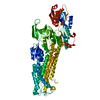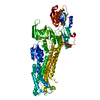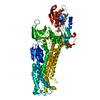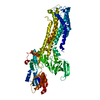+ Open data
Open data
- Basic information
Basic information
| Entry | Database: PDB / ID: 7xun | |||||||||||||||
|---|---|---|---|---|---|---|---|---|---|---|---|---|---|---|---|---|
| Title | Structure of ATP7B C983S/C985S/D1027A mutant | |||||||||||||||
 Components Components | Copper-transporting ATPase 2 | |||||||||||||||
 Keywords Keywords | TRANSLOCATE / METAT TRANSPORT / P-type Cu(+) transporter /  Translocase / METAL TRANSPORT Translocase / METAL TRANSPORT | |||||||||||||||
| Function / homology |  Function and homology information Function and homology informationprotein maturation by copper ion transfer / P-type divalent copper transporter activity / P-type monovalent copper transporter activity / P-type Cu+ transporter / copper ion export / copper ion import / copper ion transmembrane transporter activity / sequestering of calcium ion / copper ion transport / xenobiotic detoxification by transmembrane export across the plasma membrane ...protein maturation by copper ion transfer / P-type divalent copper transporter activity / P-type monovalent copper transporter activity / P-type Cu+ transporter / copper ion export / copper ion import / copper ion transmembrane transporter activity / sequestering of calcium ion / copper ion transport / xenobiotic detoxification by transmembrane export across the plasma membrane / intracellular zinc ion homeostasis / response to copper ion / Ion transport by P-type ATPases / intracellular copper ion homeostasis /  lactation / monoatomic ion transmembrane transport / trans-Golgi network membrane / establishment of localization in cell / late endosome / copper ion binding / lactation / monoatomic ion transmembrane transport / trans-Golgi network membrane / establishment of localization in cell / late endosome / copper ion binding /  Golgi membrane / Golgi membrane /  Golgi apparatus / Golgi apparatus /  ATP hydrolysis activity / ATP hydrolysis activity /  mitochondrion / mitochondrion /  ATP binding / ATP binding /  membrane / membrane /  plasma membrane plasma membraneSimilarity search - Function | |||||||||||||||
| Biological species |   Homo sapiens (human) Homo sapiens (human) | |||||||||||||||
| Method |  ELECTRON MICROSCOPY / ELECTRON MICROSCOPY /  single particle reconstruction / single particle reconstruction /  cryo EM / Resolution: 3.4 Å cryo EM / Resolution: 3.4 Å | |||||||||||||||
 Authors Authors | Yang, G. / Xu, L. / Guo, J. / Wu, Z. | |||||||||||||||
| Funding support |  China, 4items China, 4items
| |||||||||||||||
 Citation Citation |  Journal: Cell Rep / Year: 2023 Journal: Cell Rep / Year: 2023Title: Structures of the human Wilson disease copper transporter ATP7B. Authors: Guo-Min Yang / Lingyi Xu / Rou-Min Wang / Xin Tao / Zi-Wei Zheng / Shenghai Chang / Demin Ma / Cheng Zhao / Yi Dong / Shan Wu / Jiangtao Guo / Zhi-Ying Wu /  Abstract: The P-type ATPase ATP7B exports cytosolic copper and plays an essential role in the regulation of cellular copper homeostasis. Mutants of ATP7B cause Wilson disease (WD), an autosomal recessive ...The P-type ATPase ATP7B exports cytosolic copper and plays an essential role in the regulation of cellular copper homeostasis. Mutants of ATP7B cause Wilson disease (WD), an autosomal recessive disorder of copper metabolism. Here, we present cryoelectron microscopy (cryo-EM) structures of human ATP7B in the E1 state in the apo, the putative copper-bound, and the putative cisplatin-bound forms. In ATP7B, the N-terminal sixth metal-binding domain (MBD6) binds at the cytosolic copper entry site of the transmembrane domain (TMD), facilitating the delivery of copper from the MBD6 to the TMD. The sulfur-containing residues in the TMD of ATP7B mark the copper transport pathway. By comparing structures of the E1 state human ATP7B and E2-P state frog ATP7B, we propose the ATP-driving copper transport model of ATP7B. These structures not only advance our understanding of the mechanisms of ATP7B-mediated copper export but can also guide the development of therapeutics for the treatment of WD. | |||||||||||||||
| History |
|
- Structure visualization
Structure visualization
| Structure viewer | Molecule:  Molmil Molmil Jmol/JSmol Jmol/JSmol |
|---|
- Downloads & links
Downloads & links
- Download
Download
| PDBx/mmCIF format |  7xun.cif.gz 7xun.cif.gz | 146.3 KB | Display |  PDBx/mmCIF format PDBx/mmCIF format |
|---|---|---|---|---|
| PDB format |  pdb7xun.ent.gz pdb7xun.ent.gz | 107.5 KB | Display |  PDB format PDB format |
| PDBx/mmJSON format |  7xun.json.gz 7xun.json.gz | Tree view |  PDBx/mmJSON format PDBx/mmJSON format | |
| Others |  Other downloads Other downloads |
-Validation report
| Arichive directory |  https://data.pdbj.org/pub/pdb/validation_reports/xu/7xun https://data.pdbj.org/pub/pdb/validation_reports/xu/7xun ftp://data.pdbj.org/pub/pdb/validation_reports/xu/7xun ftp://data.pdbj.org/pub/pdb/validation_reports/xu/7xun | HTTPS FTP |
|---|
-Related structure data
| Related structure data |  33475MC  7xukC  7xumC  7xuoC  8ioyC M: map data used to model this data C: citing same article ( |
|---|---|
| Similar structure data | Similarity search - Function & homology  F&H Search F&H Search |
- Links
Links
- Assembly
Assembly
| Deposited unit | 
|
|---|---|
| 1 |
|
- Components
Components
| #1: Protein | Mass: 162033.516 Da / Num. of mol.: 1 Source method: isolated from a genetically manipulated source Source: (gene. exp.)   Homo sapiens (human) / Gene: ATP7B / Cell line (production host): HEK293 / Production host: Homo sapiens (human) / Gene: ATP7B / Cell line (production host): HEK293 / Production host:   Homo sapiens (human) / References: UniProt: P35670, P-type Cu+ transporter Homo sapiens (human) / References: UniProt: P35670, P-type Cu+ transporter |
|---|
-Experimental details
-Experiment
| Experiment | Method:  ELECTRON MICROSCOPY ELECTRON MICROSCOPY |
|---|---|
| EM experiment | Aggregation state: PARTICLE / 3D reconstruction method:  single particle reconstruction single particle reconstruction |
- Sample preparation
Sample preparation
| Component | Name: ATP7B Wilson disease protein / Type: ORGANELLE OR CELLULAR COMPONENT / Entity ID: all / Source: RECOMBINANT Wilson disease protein / Type: ORGANELLE OR CELLULAR COMPONENT / Entity ID: all / Source: RECOMBINANT |
|---|---|
| Molecular weight | Experimental value: NO |
| Source (natural) | Organism:   Homo sapiens (human) Homo sapiens (human) |
| Source (recombinant) | Organism:   Homo sapiens (human) / Cell: HEK293 Homo sapiens (human) / Cell: HEK293 |
| Buffer solution | pH: 7.4 |
| Specimen | Embedding applied: NO / Shadowing applied: NO / Staining applied : NO / Vitrification applied : NO / Vitrification applied : YES : YES |
Vitrification | Cryogen name: ETHANE |
- Electron microscopy imaging
Electron microscopy imaging
| Experimental equipment |  Model: Titan Krios / Image courtesy: FEI Company |
|---|---|
| Microscopy | Model: FEI TITAN KRIOS |
| Electron gun | Electron source : :  FIELD EMISSION GUN / Accelerating voltage: 300 kV / Illumination mode: OTHER FIELD EMISSION GUN / Accelerating voltage: 300 kV / Illumination mode: OTHER |
| Electron lens | Mode: BRIGHT FIELD Bright-field microscopy / Nominal defocus max: 1300 nm / Nominal defocus min: 1100 nm Bright-field microscopy / Nominal defocus max: 1300 nm / Nominal defocus min: 1100 nm |
| Image recording | Electron dose: 62 e/Å2 / Film or detector model: GATAN K2 SUMMIT (4k x 4k) |
- Processing
Processing
| Software | Name: PHENIX / Version: 1.19.2_4158: / Classification: refinement | ||||||||||||||||||||||||
|---|---|---|---|---|---|---|---|---|---|---|---|---|---|---|---|---|---|---|---|---|---|---|---|---|---|
CTF correction | Type: PHASE FLIPPING AND AMPLITUDE CORRECTION | ||||||||||||||||||||||||
3D reconstruction | Resolution: 3.4 Å / Resolution method: FSC 0.143 CUT-OFF / Num. of particles: 338254 / Symmetry type: POINT | ||||||||||||||||||||||||
| Refine LS restraints |
|
 Movie
Movie Controller
Controller







 PDBj
PDBj





